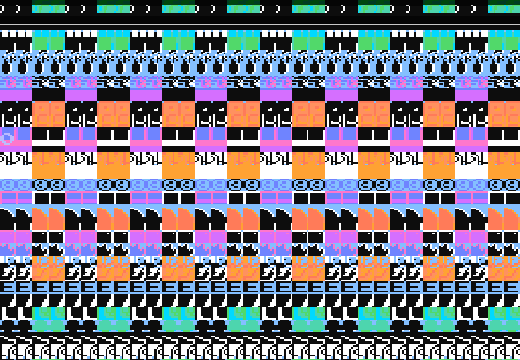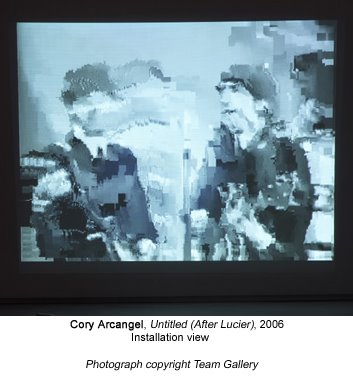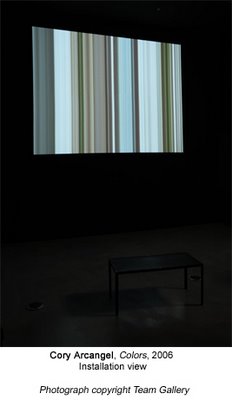View current page
...more recent posts

Two fairly active threads on Cory Arcangel, Paul B. Davis, and matters BEIGE: the conversation starts here and seems to be continuing here. So far Paddy Johnson's questions from last fall--about Untitled Translation Exercise in particular--aren't being answered, although some good points have been made overall. Once again some fairly persistent commenter(s) are avoiding the issues and accusing me of personal belligerence and hostility. This rather proves my point that the discussion around BEIGE these days isn't about issues but about declaring for or against certain artists. We need to get over this.
Update: A couple of comments about UTE have been made since I posted.


Meanwhile, in an alternate universe where more than one artist using the computer broke through to staggering international recognition, making new media people all jumpy and feeling like they had to "declare":
PAUL B. DAVIS [BEIGE]I fondly recall the turntable with the 8-Bit Construction Set LP in the front room of the old Team Gallery, crammed with other BEIGE work.
INTENTIONAL COMPUTING
Seventeen Gallery, London, 30th May Ė 23rd June 2007
Paul B. Davis is obsessed with computers and makes art that helps him understand how they work. Heís a founder member of the pioneering programming ensemble BEIGE along with Cory Arcangel, Joe Beuckman and Joseph Bonn.
This exhibition comprises two large projections. Five in One, 2007 is a new NES hack that takes its form from the pirate video game cartridges that first alerted Davis to the possibility of intervening with games. These Ďmulticartsí often had for or five different games on one cartridge and echoing this, Davis is presenting five different works on one machine. Fittingly these pirated works are not all by Davisí hand, as he loots excerpts from other BEIGE collective hacks, questioning authorship in the already grey area of software as readymade. The second piece is a new video, a collaboration with the trans-media collective Paper Rad, which accentuates and aesthecises artefacts inherent in video compression formats, particularly MPEG-4 [titled Video Compression Study II, 2007]. A third work, in collaboration with Cory Arcangel, titled Fat Bits, is a triptych of monitors which presents close up images of an NHL ice hockey game, converted into imagery housed in an NES. Reminiscent of the timeless NES Ice Hockey game, these abstracted motions of brawling figures present a bacon-esque scene, groaning and grunting in a slow motion and distorted struggle.
Aesthetically Davisí images are solid slabs of reordered, pure proto-modernist colour. With his alterations a new game, a new screen and a new surface emerges. The materiality of a hacked game cartridge, set into the instantly recognisable Nintendo console, guarantees that the recession into a purely two-dimension digital fold is never as total as it is in the work of other digital artists, the work remains an object. Further, the dizzying hyper-graphics of many related practitioners are surrendered in favour of the neat, blocky pixilation of the outdated NES operating system. This show also includes an installation featuring 8-bit Construction Set Ė an art/music/concept work rendered in vinyl which will be mounted on a record deck within the gallery, visitors being invited to play it out to their own satisfaction.
Quoting his influences as ranging from formalised British computing theory (Alan Turing) to the advent of widespread domestic console gaming (Mario), Davis has pioneered a truly unique strategy through a multiplicity of actions, networks and artistic creations. Davisí practise is at once rigorous, conceptual Ė even nerdy, while nonetheless fully intimate with the patois, style, attitude and aesthetic of retrogressively inspired, data-bit multi-media contemporary culture, that has recently forced its way into the public consciousness.
Below is Paddy Johnson's review of Cory Arcangel's "...participatory culture" show at Team Gallery last year. While critical, it is ultimately respectful and merely expresses what many thought about the show but were too cautious to say for fear of jinxing the first non-sucky computer artist to break through to art world recognition. Including me, even though I felt the show was a step back to the "BitStreams" era. I'm bringing it up now because recent writing about the artist seems to be adopting a strangely defensive or belligerent tone--it's as if you have declare whether you're for or against him, and I think we need to get over this. This review was not reBlogged by Eyebeam or Rhizome, the main new media sites, which also seems like a partisan and slightly juvenile snub. The issues are worth discussing.
I have been spending a lot of time thinking about how to discuss New Media artist Cory Arcangelís new exhibition, subtractions, modifications, addenda, and other recent contributions to participatory culture at Team Gallery, and itís not the exercise in fun it usually is. Writing about my friends is great when Iíve only got compliments to bestow, but itís another ball of wax when I leave their exhibition with a mental list of artists who have done similar work.Donít get me wrong, subtractions, modifications, addenda, and other recent contributions to participatory culture, isnít entirely derivative, nor is it a bad show per say, but it does inspire a number of questions, that arenít easily resolved. Probably the strongest work in the show is Untitled Translation Exercise, a modified version of Dazed and Confused, a film by Richard Linklater, which now features the redubbed voices of Indian actors performing the screenplay in English. The original movie is a coming of age story about a group of American high schools students experiencing the anxiety, boredom, and fervor of teenage years, so Arcangelís choice to outsource the dialogue, both heightens the viewerís sense of what it means to be American, and reflects the development of new industries in the United States.
Youíd think these ideas would be enough to stamp the piece as good and be done with it, but I canít reconcile the feeling that the decision to outsource the filmís dialogue isnít entirely resolved. There are simply too many loose ends at play here. What does the work gain by outsourcing labor that has already been completed? Was it necessary to make a feature length movie? Does the filmís narrative support the alteration? These questions donít come up in Woody Allenís similarly conceived, Whatís Up Tiger Lily, a 1966 film whereby the director purchased a Japanese spy movie, removed the sound track and replaced it with his own. Clearly the two films are different, but you canít say the approach doesnít, at the very least, merit comparison.

The other video based works in the exhibition do not invite specific film references the way Untitled Translation Exercise does, but they do seem awfully close to work that has already been made. Arcangelís Colors for example, extends pixels line by line in the Dennis Hopper movie by the same name to create a moving vertical pattern reminiscent of New Media artist Jason Salavonís The Top Grossing Film of All Time 1◊1. Exhibited in 2001 at the Whitneyís exhibition Bitstreams, the artist uses the average color of each frame in the movie Titanic, and arranges them in a digital c-print to follow the narrative sequence they would have appeared in. I suspect the programs each artist wrote to create their work were difficult to execute, but unlike the work of Salavon, those with even a small amount of website construction experience will be familiar with the technique of expanding pixels, and subsequently wonít find the Arcangel manipulation all that interesting. Even without this knowledge, I imagine many viewers will still be left wondering what the point of the alteration is (other than to create a moderately attractive picture).

The reason these issues exist in this work, as with Untitled (After Lucier), a video loop of the Beatles on The Ed Sullivan show which compresses and loses image quality with each repetition, is that in each case, the content is subservient to the technology. And unfortunately, just as painting about painting is dull, so is tech art about tech. The thing is, Arcangel knows this, so despite the fact that some of the work in this show falls short, I have trouble believing that the exhibition is some sort of sign of things to come. Two weeks ago at Vertexlist, the artist performed pieces from his record The Bruce Springsteen ĎBorn To Runí Glockenspiel Addendum (also part of his show), and while, I canít claim to understand why the record needed to be a remix album (the artist composed five Glockenspiel pieces for the Bruce Springsteen album Born to Run, in addition to the three Springsteen had already written, matched them to the time count of the music, and removed the original music), his performance demonstrated his usual brilliance. There was a charming awkwardness to his playing, which made the piece at once humble, moving, and strangely funny. In fact, it was so enjoyable, that the thought occurred to me that while subtractions, modifications, addenda, and other recent contributions to participatory culture, isnít the best thing the artist has ever done, if he had thrown a performance into his show, nobody would have ever known the difference.

Calling Cthulhu by Erik Davis:
For [H.P.] Lovecraft, scientific materialism is the ultimate Faustian bargain, not because it hands us Promethean technology (a man for the eighteenth century, Lovecraft had no interest in gadgetry), but because it leads us beyond the horizon of what our minds can withstand. "The most merciful thing in the world, I think, is the inability of the mind to correlate all its contents," goes the famous opening line of "Call of Cthulhu." By correlating those contexts, empiricism opens up "terrifying vistas of reality"ówhat Lovecraft elsewhere calls "the blind cosmos [that] grinds aimlessly on from nothing to something and from something back to nothing again, neither heeding nor knowing the wishes or existence of the minds that flicker for a second now and then in the darkness."Davis's essay considers the before-and-after role of religion in HPL's prose: elements of magic and ritual appropriated by the author for his world of materialistic horror as well as attempts by various cults and Internet wackos to claim the Necronomicon as an authentic text. The in-depth research illuminates but possibly ameliorates Lovecraft. Davis's emphasis on the "Outside Within," a domain of eldritch visions that can be instructive as well as devastating to the religious seeker, breaks the spell that HPL is indeed describing malevolent conspiracies beyond the control of our Enlightened societies and diminishes his central insight: that these forces are real. (Cue organ.) I prefer the political dimension that some writers have claimed for the Providence recluse, such as Robert Bloch's litany of "modern horrors" not generally cognizable at the time Lovecraft wrote his stories but making him only too relevant to current readers: serial killers operating in the cracks of civilization, technologically assisted genocide, horrors beyond our capacity to absorb horror--to which one might add the televised mass chaos post-Katrina and the drill-killing insanity in Iraq unleashed by Dick Cheney, the ultimate Lovecraftian leader.
Lovecraft gave this existentialist dread an imaginative voice, what he called "cosmic alienage." For Fritz Leiber, the "monstrous nuclear chaos" of Azathoth, Lovecraft's supreme entity, symbolizes "the purposeless, mindless, yet all-powerful universe of materialistic belief." But this symbolism isn't the whole story, for, as DMT voyagers know, hyperspace is haunted. The entities that erupt from Lovecraft's inhuman realms seem to suggest that in a blind mechanistic cosmos, the most alien thing is sentience itself. Peering outward through the cracks of domesticated "human" consciousness, a compassionless materialist like Lovecraft could only react with horror, for reason must cower before the most raw and atavistic dream-dragons of the psyche.
Modern humans usually suppress, ignore or constrain these forces lurking in our lizard brain. Mythically, these forces take the form of demons imprisoned under the angelic yokes of altruism, morality, and intellect. Yet if one does not believe in any ultimate universal purpose, then these primal forces are the most attuned with the cosmos precisely because they are amoral and inhuman. In "The Dunwich Horror," Henry Wheeler overhears a monstrous moan from a diabolical rite and asks "from what unplumbed gulfs of extra-cosmic consciousness or obscure, long-latent heredity, were those half-articular thunder-croakings drawn?" The Outside is within.
[Thanks to Davis for the shout to this blog a while back--I'm disagreeing with him a bit here but his nod made my week--Techgnosis is awesome.]
Photo: Cthulhu (and other carvings against uniformly blue backgrounds) from Monolith Design. "Monolith Design was founded in 1990 by Stephen Mussared and is committed to producing carefully researched, well-made gaming miniatures for a wide variety of scales and periods, from Ancient Egyptian through Twentieth Century to Science Fiction and Fantasy. The models are cast in high quality resin [...]" [via travis about two years ago]


Belatedly posting my tourist photos from the National Museum of the American Indian on the Mall in DC. Forgot to bring the USB cable for my camera when posting from the road--this was almost like getting snapshots from the drugstore after the trip. That's beadwork in the top picture--I love the calmness and focus of the pattern. Below is the sci fi ceiling of the space-hogging but dramatic atrium. The outside is kind of spacy too but it's adobe-oid so it's not too anomalous. One supposes the atrium mimics an igloo but its lines are predominantly modernist. [Friends, family in DC please don't be mad if I didn't reach you--this was a brief stopover on the way down to Charlottesville for my college radio station reunion.]
Update: We're discussing the premises of the museum here.

Juan Cole on Iran war propaganda:
Polling shows that the percentage of Americans who view Iran as the number one threat to the United States has risen to 27 percent now. I think it was only 20 percent in December 2006. First of all, how in the world can a developing country with about a fourth of the population of the US, about a $2000 per capita income (in real terms, not local purchasing power), with no intercontinental ballistic missiles, with no weapons of mass destruction (and no proof positive it is trying to get them), with a small army and a small military budget-- how is such a country a "threat" to the United States of America? Iranian leaders don't like the US, and they talk dirty about the US, and they do attempt to thwart US interests. The same is true of Venezuela under Chavez. But Tehran is a minor player on the world stage, and trying to build it up to replace the Soviet Union is just the worst sort of fear-mongering, and it is being done on behalf of the US military industrial complex, which wants to do to Iran what it did to Iraq. It is propaganda, and significant numbers of Americans (a 7 percent increase would be like 21 million people!) are buying it.Many higher ups in media and the government don't know the difference between Sunni Muslims (comprising most of the Iraq insurgents) and Shiite Muslims (comprising the majority of Iraqis and almost all Iranians). Or that Iranians are Persian, not Arab. How can millions of Americans understand that if it isn't explained to them?
Why have those poll numbers gone up? Because the Bush administration is trying to hang the Sunni Arab insurgency in Iraq on Iran (and even trying to hang the Taliban resurgence in Afghanistan on Iran). The message of administration and military spokesmen is that Iran is deliberately killing US troops and is a major source of insurgency in Iraq. No convincing evidence has ever been presented for either allegation, nor is it reasonable to assume that Iran plays a significant role in funding hyper-Sunni, Shiite-killing death squads to deliberately destabilize its client governments in Baghdad (al-Maliki) and Kabul (Karzai). Yet the New York Times and even the Guardian put this b.s. on the front page, and of course it is all over CNN, Fox Cable News, MSNBC, etc. Are US journalists trapped in the the dictates of the military-industrial complex by virtue of working for these mega corporations? We know that Roger Ailes at Fox Cable News orders his employees how to spin the day's news (he is a former high Republican Party official). Has any of the journalists counted up how many of the 127 US troops killed in Iraq in May was killed in Sunni Arab areas and how many in Shiite neighborhoods? Has any of them actually read the translated communiques on World News Connection of the Sunni Arab guerrillas and what they say about Iran and Shiites? Has any demanded air tight proof and non-anonymous sources before printing this garbage?
No.
Rest in Peace, Steve Gilliard.

The best, most honest, least compromising political blogger, Steve Gilliard, has died. He had a devastating sense of humor and no careerist agenda beyond excellent writing and saying exactly what he thought. Meaning that, unlike DailyKos or MyDD, he didn't use his blog for political activity and he didn't hang with politicians. He also wasn't looking to "move up" to the mainstream media--in fact, he often boasted that his readership was as large as many lefty print mags, so why did he need to join them? And he didn't just vent, he did his homework--for example, a memorable, well-researched series on the history of colonial warfare, from a strategic viewpoint. Reading those case studies helped you to recognize the Iraq War for what it is and also, strangely optimistically, to know that it is a 19th Century relic and therefore doomed (if optimism is the right word for an experiment with such a great human cost). Gilliard remains an inspiration and an ethical yardstick for all attempting to step out of established modes of communication. He will be celebrated long after the Tim Russerts and Peter Beinarts are forgotten jokes of history.
(photo by Lindsay Beyerstein)

